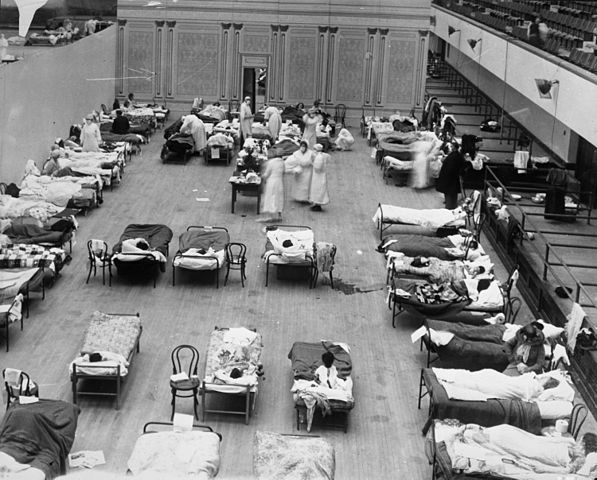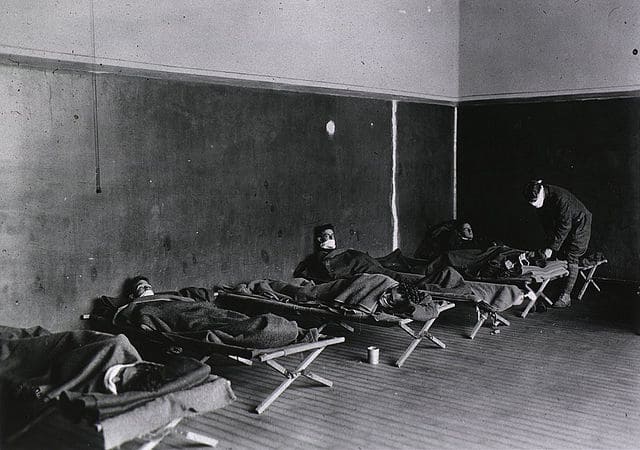The Spanish flu was a deadly influenza that hit the globe in 1918. Between 50 and 100 million people died from it. That makes it the deadliest pandemic the world has ever seen.
What was the Spanish flu?
The Spanish flu was a respiratory disease.

The virus that causes it is related to common influenza.
And like common influenza, it attaches itself to the airways of the host. When it attaches to the lungs, these get inflamed.
The issue with this virus was that it was new among humans. So when it first hit them, they did not have any immunity against it. Their bodies did not know how to fight it. That allowed the virus to roam free and wreak havoc.
The scientists called this variation of the virus H1N1. An ancestor of H1N1 had probably been circulating among either birds or pigs for a while. But then, that virus mutated. The mutation gave it the ability to infect humans, and furthermore, to jump from one human to the next. The mutation had turned the virus into the deadly H1N1.
The pandemic broke out in the Spring of 1918, in the middle of World War I. It began in military camps and quickly spread to the towns and cities.
The pandemic only lasted a year. But it was not always present during that time. It came and went in three waves, with the second wave being the deadliest.
Don’t miss: What Worked Against the Spanish Flu, and What Finally Stopped It
What were the symptoms of the Spanish flu?
Most of the people that caught the Spanish flu had mild symptoms or no symptoms at all. But a percentage became seriously ill.
In the beginning, the epidemic startled doctors since the sick were reporting so many symptoms.
Some patients had chills, fever, sore throat, difficulty breathing, cough, and headache. So their illness was recognized as a type of flu.
But other patients with the same disease would bleed through the nose, ears, and even eyes. A German researcher wrote that “hemorrhages occurring in different parts of the interior of the eye” were frequent.
The hardest-hit victims coughed blood and other secretions from the lungs.
Many patients turned blue due to the lack of air within hours of the onset of the symptoms. That turning blue is called cyanosis. And then they would abruptly die of either bacterial or viral pneumonia (pneumonia is lung inflammation).
Others yet presented paralysis, and even emotional-mental symptoms like depression or suicidal tendencies.
Hemorrhages, coughing blood, cyanosis, paralysis, mental issues were not usual symptoms of the flu. Plus, most of the victims were young men. And young men do not tend to die from the flu.
So what was this? And why did some patients only have flu-like symptoms while others developed other conditions?
A doctor of Camp Devens, a military camp near Boston which was hit by the pandemic during the Fall of 1918, wrote on September 29:
“These men start with what appears to be an ordinary attack of… influenza, and when brought to the hospital ,they very rapidly develop the most vicious type of pneumonia that has ever been seen… and a few hours later, you can begin to see the cyanosis extending from their ears and spreading all over the face, until it is hard to distinguish the colored men from the white. It is only a matter of a few hours then until death comes… It is horrible… We have been averaging about 100 deaths per day… Pneumonia means in about all cases death…“
Meanwhile, the chief pathologist of New York City’s Health Department said: “Cases with intense pain look and act like cases of dengue… hemorrhage from nose or bronchi… paresis or paralysis of either cerebral or spinal origin… impairment of motion may be severe or mild, permanent or temporary… physical and mental depression… led to hysteria, melancholia, and insanity with suicidal intent.”
Read next: 6 Traits That Made the Spanish Flu Unique
Identifying the disease

Because of the unusual and many symptoms, the Spanish flu was misdiagnosed from Europe to the Americas. It was thought to be cholera, typhoid fever, dengue, or meningitis.
And autopsies did little to make the picture clearer. Doctors in France found that the lungs of some of the diseased looked like they had inhaled mustard gas.
All this was happening during the last year of WWI. And the first cases appeared in the European trenches and in the military training camps in the U.S. So, in the beginning, the Allies thought the disease was a product of biological warfare from the Germans.
It would take doctors some time to understand exactly what they were dealing with, and that it was indeed influenza. Albeit, an ultra lethal strain.
Read also:
Key to the Spread of the Spanish Flu: the War
The Real Origin of the 1918 Flu Pandemic
How Many Died From the Spanish Flu? Per country and continent
More Articles








